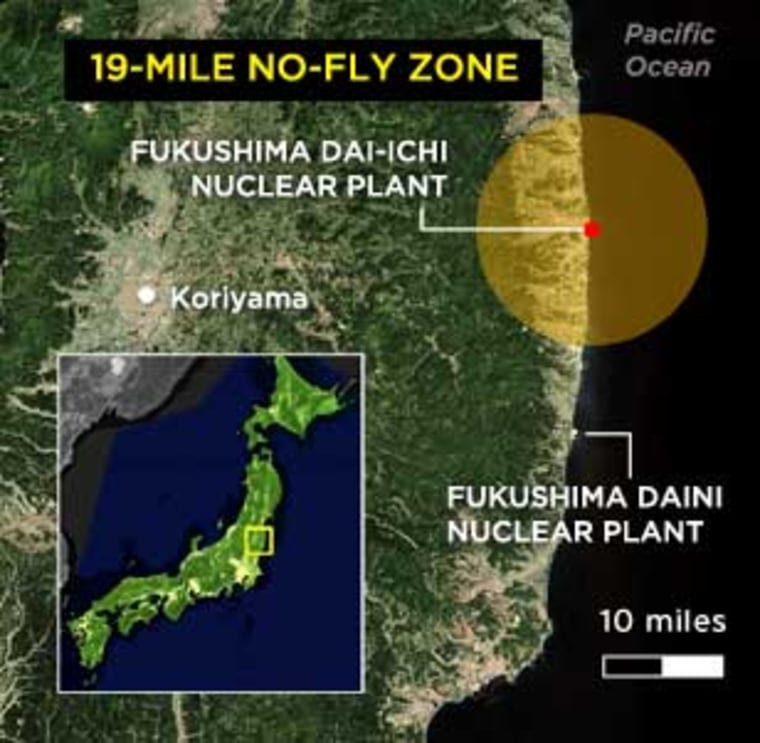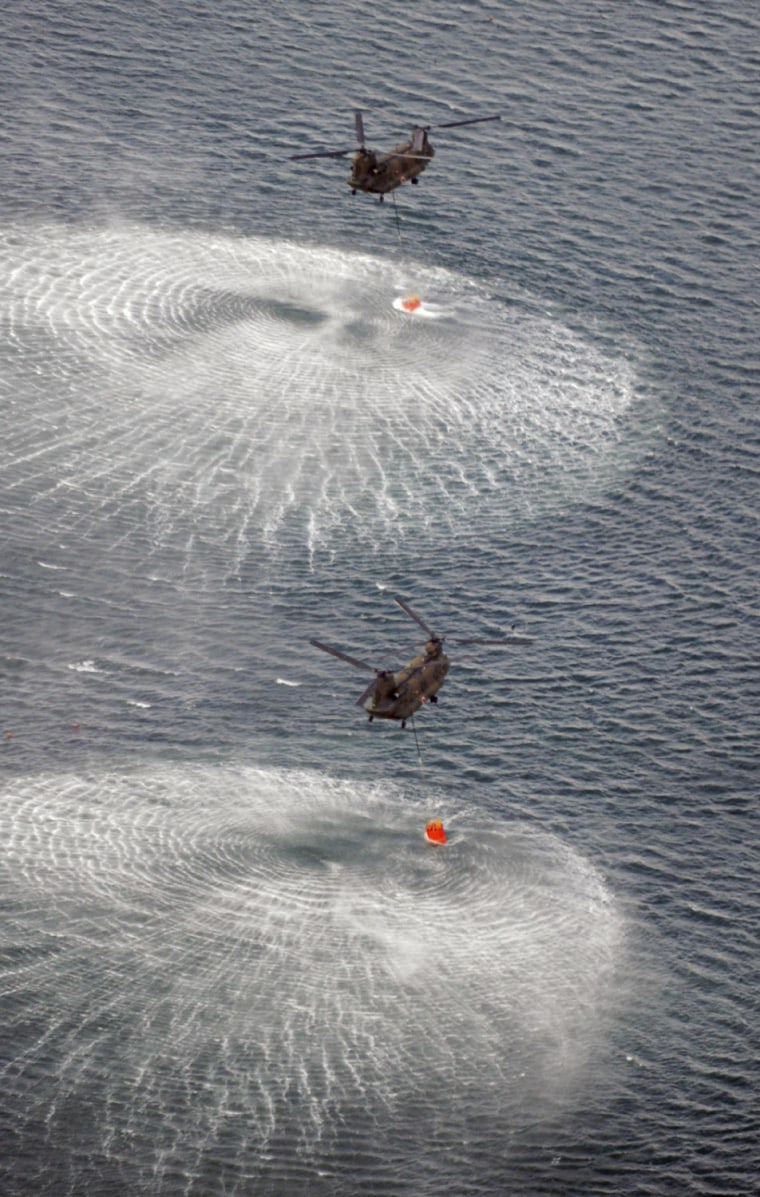TOKYO — Japanese military helicopters dumped loads of seawater onto a stricken nuclear complex Thursday, trying to cool dangerously overheated uranium fuel rods that may be on the verge of spewing more radiation into the atmosphere.
The extraordinary, combat-style tactics came as plant operators said they were racing to finish a new power line that could restore cooling systems and ease the crisis. Still, U.S. officials warned all Americans living within 50 miles of the Fukushima Dai-ichi plant to leave the area or at least remain indoors.
The Japanese government said it had no plans to expand its 20-kilometer (13-mile) evacuation zone around the complex.
The crisis at the nuclear complex was set off when last week's earthquake and tsunami knocked out power and destroyed backup generators needed for the reactors' cooling systems, adding a major nuclear crisis for Japan as it struggled with twin natural disasters that killed more than 10,000 people and left hundreds of thousands homeless.
Japanese military CH-47 Chinook helicopters began dumping seawater on the complex's damaged Unit 3 at 9:48 a.m. (0048 GMT, 8:48 p.m. EDT), said defense ministry spokeswoman Kazumi Toyama. The choppers dumped at least four loads on the reactor, though television footage showed much of it appearing to disperse in the wind.
At least a dozen more loads were planned in the 40 minutes each crew can work to limit their radiation exposure, the ministry said.

The water drops were aimed at cooling the Unit 3 reactor, as well as replenishing water in that unit's cooling pool, where used fuel rods are stored, Toyama said. The plant's owner, Tokyo Electric Power Co., said earlier that the pool was nearly empty, which would cause the rods to overheat and emit even more radiation.
Defense Minister Toshifumi Kitazawa told reporters that emergency workers had no choice but to try the water dumps before it was too late.
A high-pressure fire truck from the Tokyo Metropolitan Police Department is also set to begin spraying water onto the No. 4 reactor building.
Also Thursday officials said that they were close to completing a new power line that could restore the reactors' cooling systems.
Naoki Tsunoda, a TEPCO spokesman, said the new power line to the plant was almost finished and that officials planned to try it "as soon as possible." Kyodo News said that could be as early as Thursday afternoon.
The new line could revive electric-powered pumps, allowing the company to maintain a steady water supply to troubled reactors and spent fuel storage ponds, keeping them cool. The company is also trying to repair its existing disabled power line.
US warns of dire situation
On Wednesday, the United States expressed increasing alarm about the the threat posed by nuclear crisis, with its top nuclear energy chief suggesting that one crippled reactor was in danger of a complete meltdown.
Gregory Jaczko, chairman of the U.S. Nuclear Regulatory Commission, painted a much bleaker picture of the situation at the Fukushima Dai-ichi plant than Japanese officials. He told a congressional hearing in Washington that all the water was gone from the spent fuel pools at Unit 4, one of six reactors at the complex.
"There is no water in the spent fuel pool and we believe that radiation levels are extremely high, which could possibly impact the ability to take corrective measures," he said.
Japanese officials denied that all the cooling water was gone. Hajime Motojuku, spokesman for plant operator Tokyo Electric Power Co., said the "condition is stable" at Unit 4.
If Jaczko is correct, it would mean there's nothing to stop the fuel rods from getting hotter and ultimately melting down. The outer shells of the rods could also ignite with enough force to propel the radioactive fuel inside over a wide area.
Jaczko did not say how the information was obtained, but the NRC and U.S. Department of Energy both have experts at the Fukushima complex along Japan's northeastern coast, which was ravaged by last week's magnitude-9.0 earthquake and subsequent tsunami.
As international concern mounted, the chief of the U.N. nuclear agency said he would go to Japan to assess what he called a "serious" situation and urged Tokyo to provide better information to his organization.
Yukiya Amano of the International Atomic Energy Agency spoke of a "very serious" situation and said he would leave for Tokyo within a day.
He said it was "difficult to say" if events were out of control, but added, "I will certainly have contact with those people who are working there who tackled the accident, and I will be able to have firsthand information."
Japan says it's keeping its people safe
Yukio Edano, Japanese chief cabinet secretary, said Thursday at a news conference that water was depleted in Unit 4 and acknowledged a time lag in reporting information to U.S. authorities.
However, a wider evacuation area is not needed, he said. If it were, Japan would issue a national warning for people to evacuate.
"We as nationals want to make sure our people are safe, and will take appropriate actions," Edano said.
He also said President Barack Obama phoned Japanese Prime Minister Naoto Kan and during the 30-minute call pledged U.S. support for the nuclear plants and other long- and short-term relief efforts. They also promised to stay in close touch during the crisis.
The U.S. Air Force said an unmanned drone was scheduled to fly over the Fukushima plant Thursday to collect data and images for the Japanese government, Lt. Gen. Herbert "Hawk" Carlisle, the Air Force deputy chief of staff for operations, said in an e-mail reported by Bloomberg.
The drone, best known for missions over Iraq and Afghanistan and which started flying anti-drug missions over Mexico last month, "is being used to help assess damage to towns, industrial infrastructure, and other facilities affected during the earthquake and flood waters," U.S. Pacific Air Forces said.
Japan's health ministry made what it called an "unavoidable" change Wednesday, more than doubling the amount of radiation to which the workers can be legally exposed.
"I don't know any other way to say it, but this is like suicide fighters in a war," said Keiichi Nakagawa, associate professor of the Department of Radiology at University of Tokyo Hospital.
Late Wednesday, government officials said they'd asked special police units to bring in water cannons — normally used to quell rioters — to spray water onto the spent fuel storage pool at Unit 4.
The cannons are thought to be strong enough to allow emergency workers to remain a safe distance from the complex while still being able to get water into the pool, said Minoru Ogoda of Japan's nuclear safety agency.
Emperor cites 'difficult days'Friday's magnitude 9 quake and tsunami pulverized Japan's northeastern coast.
The tsunami destroyed the Dai-ichi complex's backup power system and left operators unable to properly cool nuclear fuel. The 180 emergency workers have been working in shifts to manually pump seawater into the reactors.
Japan's emperor, in an unprecedented made-for-TV speech, called on the country to work together.
"It is important that each of us shares the difficult days that lie ahead," said Akihito, 77. "I pray that we will all take care of each other and overcome this tragedy."
He also expressed his worries over the nuclear crisis, saying: "With the help of those involved I hope things will not get worse."
Health experts said panic over radiation leaks from the Dai-ichi plant was also diverting attention from other threats to survivors of the quake and tsunami, such as the cold or access to fresh water.
Millions of Japanese have been with little food and water in heavy snow and rain since Friday. In some towns, long lines of cars waited outside the few open gas stations, with others lined up at rice-vending machines.
"The anxiety and anger being felt by people in Fukushima have reached a boiling point," the governor of Fukushima prefecture, Yuhei Sato, fumed in an interview with NHK. He criticized preparations for an evacuation if conditions worsen, and said centers do not have enough hot meals and basic necessities.
More than 5,100 people are officially listed as dead, but officials believe the toll will climb to well over 10,000 as about 9,700 are missing. Police say more than 452,000 people are staying in temporary shelters such as school gymnasiums.
Focus on FukushimaA radiation spike Wednesday at the complex was believed to have come from Unit 3. But officials also acknowledged that they were far from sure what was going on at the four most troubled reactors, including Unit 3, in part because high radiation levels made it difficult to get very close.
While white smoke was seen rising Wednesday above Unit 3, officials could not ascertain the source. They said it could be spewing from the reactor's spent fuel pool — cooling tanks for used nuclear rods — or may have been from damage to the reactor's containment vessel, the protective shell of thick concrete.
Masahisa Otsuki, an official with TEPCO, said officials are most concerned about the spent fuel pools, which are not encased in protective shells.
"We haven't been able to get any of the latest data at any spent fuel pools. We don't have the latest water levels, temperatures, none of the latest information for any of the four reactors," he said.
In the city of Fukushima, meanwhile, about 40 miles inland from the nuclear complex, hundreds of harried government workers, police officers and others struggled to stay on top of the situation in a makeshift command center.
An entire floor of one of the prefecture's office buildings had been taken over by people tracking evacuations, power needs, death tolls and food supplies.
Elevated levels of radiation were detected well outside the 20-mile emergency area around the plants. In Ibaraki prefecture, just south of Fukushima, officials said radiation levels were about 300 times normal levels by late morning. It would take three years of constant exposure to these higher levels to raise a person's risk of cancer.
A little radiation was also detected in Tokyo, triggering panic buying of food and water.
Given the reported radiation levels, John Price, an Australian-based nuclear safety expert, said he saw few health risks for the general public so far. But he said he was surprised by how little information the Japanese were sharing.
"We don't know even the fundamentals of what's happening, what's wrong, what isn't working. We're all guessing," he said. "I would have thought they would put on a panel of experts every two hours."
Meanwhile, the U.S. State Department called for American citizens living within 50 miles of the plant to evacuate the area or take shelter indoors. It authorized voluntary evacuations for dependents of government employees in Japan, and chartered aircraft to help private U.S.citizens wishing to leave the country.
U.S. military relief crews were banned from going within 50 miles of the plant and are receiving anti-radiation pills before missions to areas of possible radiation exposure, the Pentagon said.
